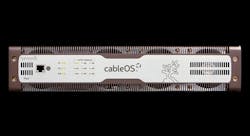Harmonic (NASDAQ: HLIT) has unveiled CableOS Reef, its new dense Remote PHY Shelf (RPS) that the company contends fundamentally changes the dynamics of cable network capacity expansion. By fully converging IP-based data, video and legacy services in centralized or remote facilities, the company says the compact indoor platform enables operators to more swiftly and economically address capacity issues while still leveraging their existing HFC outdoor access networks.
"As upstream bandwidth utilization peaks, today's operators need a fast, cost-effective and sustainable solution for expanding network capacity," observes Nimrod Ben-Natan, senior vice president and general manager, Cable Access Business at Harmonic. He adds, "CableOS Reef RPS builds on the growing success of our CableOS solution by defining a new category of DAA [distributed access architecture] that helps operators scale bandwidth rapidly utilizing their existing HFC network."
With Harmonic's CableOS Reef RPS, a cable operator's services are converged over IP and transmitted from a single RF port, saving significant wiring, space and time when a node split is needed.
Housing up to nine modular line cards in two standard rack units, each with two independent Remote-PHY devices (RPDs) for a total of 18 RPDs, Harmonic adds that CableOS Reef RPS "delivers significantly increased density relative to existing solutions and unprecedented low power consumption per service group."
Significantly, CableOS Reef RPS extends Harmonic's Pebble-inside family of R-PHY devices, which also includes the modular Ripple node. "As the only field-proven R-PHY node that provides 2x4 segmentation, the Ripple node also accelerates capacity expansion through efficient node splits, with the capability to host up to two RPDs while consuming significantly less power than traditional solutions," adds a company statement.
Harmonic contends that its family of R-PHY devices — the Reef shelf, Ripple node, Shell node and Wave shelf — now covers "every cable access deployment scenario, providing unified functionality and unprecedented flexibility" as operators address the urgent need for more bandwidth today, and in the future.
"With this future-proof solution, operators don't need to continue deploying costly legacy CMTS to address immediate bandwidth capacity issues," concludes Harmonic's Bin-Natan. "Instead, they can leverage modern technology to realize instant scalability, agility and cost-savings."
CableOS Reef RPS has successfully undergone trials with leading cable operators and is now shipping. Learn more at www.harmonicinc.com.
